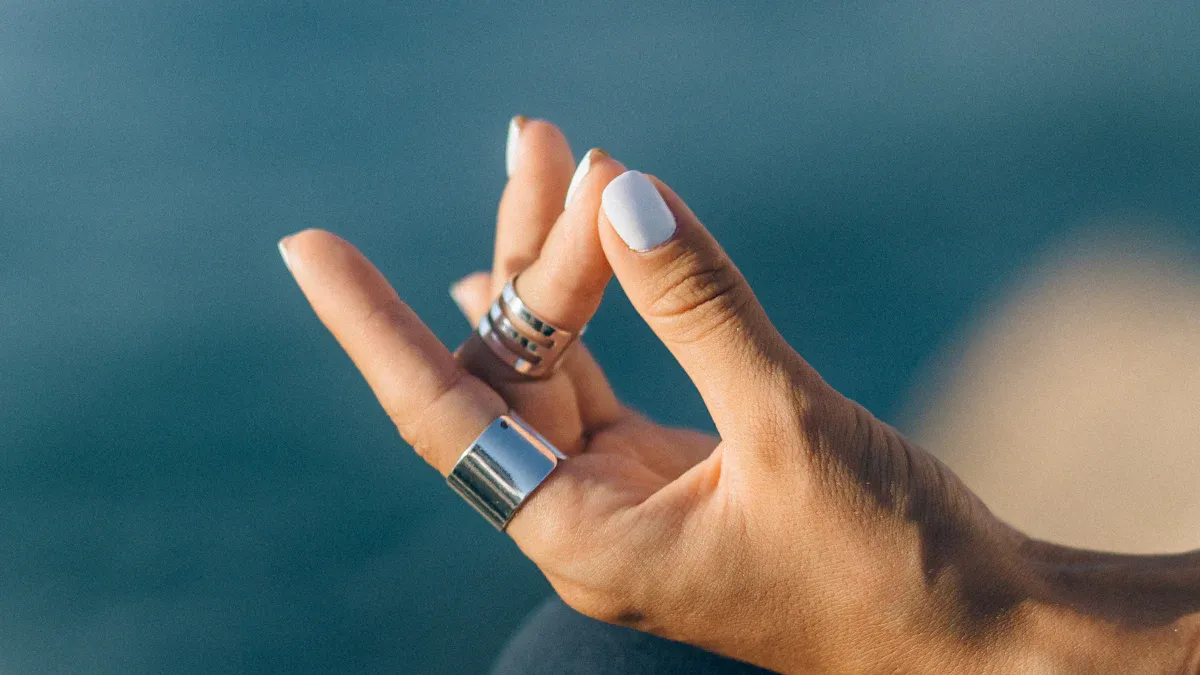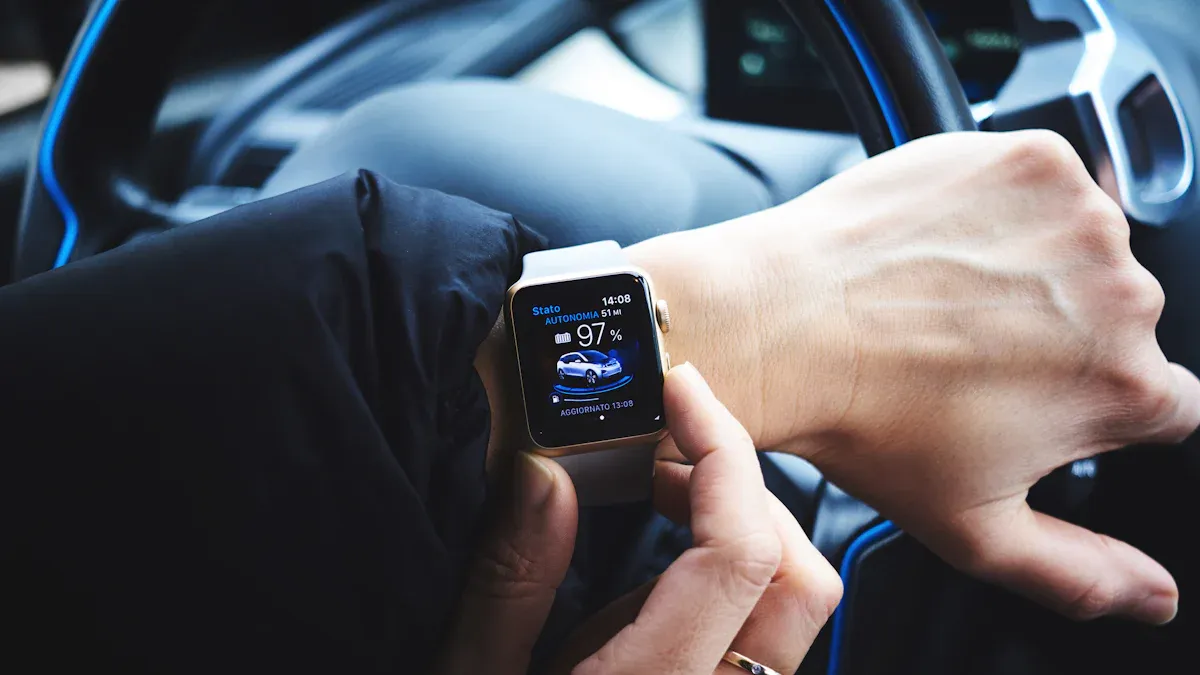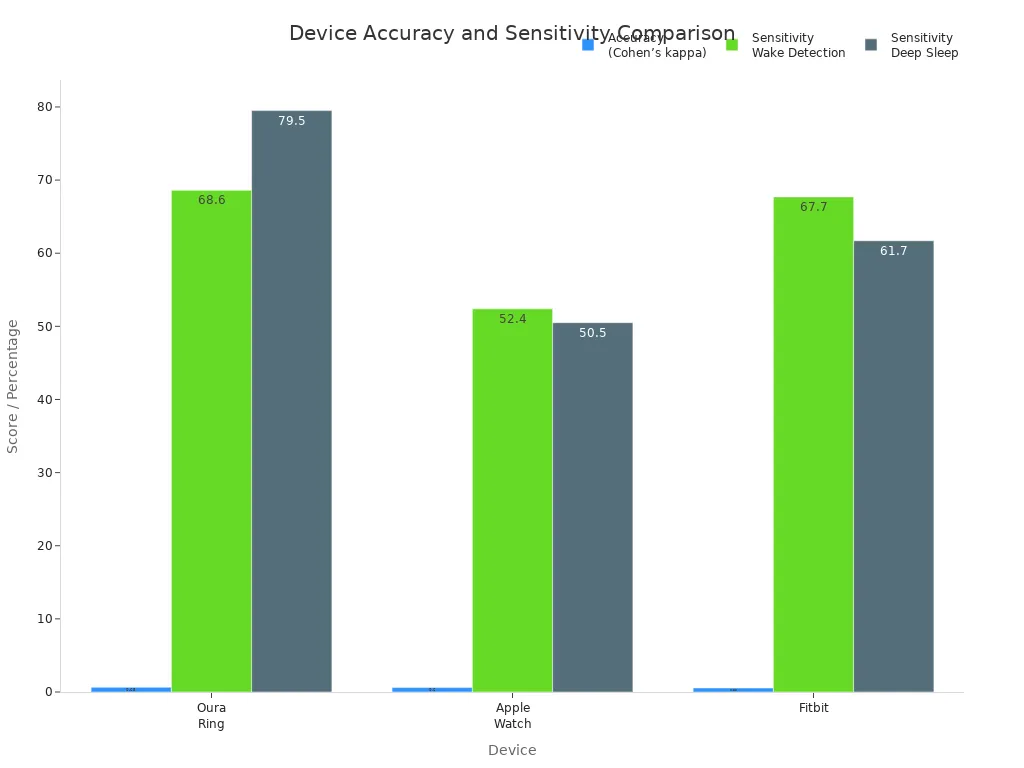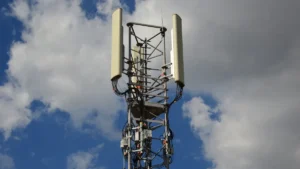
You might ask if the Oura Ring is a good fitness tracker. The Oura Ring works well for tracking sleep and activity. Many people like how it tracks sleep and movement. You can trust the Oura Ring to help you balance rest and exercise. This helps you stay healthy. But the Oura Ring might not feel good when you lift weights. It also does not track calories very well. If you wonder, “Does Oura Ring help with fitness?”—it gives you good information, but it cannot do everything a fitness tracker does.
Key Takeaways
The Oura Ring tracks your sleep and activity well. It helps you balance rest and exercise for better health. Wear the Oura Ring on your non-dominant hand. This helps it track your heart rate and steps better during workouts. The ring gives you a daily readiness score. This score tells you when to exercise or rest. It uses your recovery and sleep data to help you decide. For more workout details, use a wrist tracker with the Oura Ring. This is helpful for weightlifting or hard training. Clean the Oura Ring’s sensors often. Make sure the ring fits snugly for the best health data.
How Oura Ring Tracks Workouts
Sensors & Technology
You may wonder how the oura ring gets your health data. The oura ring has special sensors that check your body’s signals. These sensors are inside the ring and touch your skin all day. Here is a table that lists the main sensors and what they do:
Sensor Type | Functionality |
|---|---|
Infrared Photoplethysmography (PPG) | Measures heart rate and breathing by shining light with LEDs and catching the light with a photodiode. |
Negative Temperature Coefficient | Checks body temperature changes as small as 0.1° Celsius right on your skin. |
3D Accelerometer | Notices movement and activity, including daily actions and sleep. |
The oura ring uses these sensors to get details about your heart, temperature, and movement. You do not have to press any buttons. The ring works by itself when you wear it.
Metrics Provided
The oura ring gives you important numbers and scores. These help you learn about your health and fitness. The ring tracks your readiness, sleep, and activity. Here is a table that explains each score:
Metric | Description |
|---|---|
Readiness | A score out of 100 that shows how well you balance stress and rest. It uses your sleep, activity, and recovery data. |
Sleep | Measures time in deep, REM, and light sleep. It also tracks how long you take to fall asleep and your heart rate at night. You get a score out of 100. |
Activity | Tracks steps, calories burned, and how hard you move during the day. You receive a daily score out of 100. |
The oura ring uses red infrared sensors, gyroscopes, and accelerometers to check blood flow and movement. The ring’s app takes this information and makes it into easy scores. You can use these scores to see how your body reacts to each workout.
Wearing Recommendations
You get the best results if you wear the oura ring on your index, middle, or ring finger. The ring should fit snug but not too tight. If you wear it on your non-dominant hand, you might get better heart rate and movement data. Make sure the sensors always touch your skin. If the ring moves or feels loose, your data may not be as good. For the best workout tracking, keep the oura ring on during all activities, even sleep and daily movement.
Tip: Clean the sensors on your oura ring often. This helps the ring track your health better.
Cardio Workout Accuracy
Running & Walking
You want to know how well the oura ring tracks running and walking. The ring uses its sensors to measure your heart rate, steps, and movement. When you go for a walk or run, the ring starts tracking your activity automatically. You do not need to press any buttons. The ring counts your steps and checks your heart rate during your workout.
You may notice that the oura ring does not show your pace or distance in real time. If you want to see your speed or map your route, you need another device. The ring focuses on your overall movement and heart rate. Many users find the step count close to what other trackers show. The ring gives you a daily activity score based on your movement. You can use this score to see how active you are each day.
Tip: Wear the oura ring on your non-dominant hand for better step and heart rate tracking during walks and runs.
Cycling
You might wonder if the oura ring works well for cycling. The ring can detect when you start cycling, but it does not track speed or distance. It uses its sensors to measure your heart rate and movement. If you want detailed cycling data, you may need a dedicated cycling computer or a wrist-based tracker.
Here is a table that compares the oura ring to other cycling trackers:
Feature | Oura Ring | Dedicated Cycling Computers/Wrist Trackers |
|---|---|---|
Auto-detection of Activities | Strong | Varies, often more detailed |
Detailed Metrics | Limited | Comprehensive metrics available |
Accuracy in Cycling Tracking | Passable | High accuracy and detailed feedback |
You see that the oura ring does a good job of noticing when you cycle. It does not give you all the details that other devices offer. If you want to know your speed, distance, or power, you need a different tracker. The ring helps you see your heart rate and movement during your ride.
HIIT Sessions
You may try high-intensity interval training (HIIT) and want to know how the oura ring performs. The ring measures your heart rate variability (HRV) with high reliability. Studies show that the oura ring matches medical-grade devices for HRV about 98.4% of the time. This means you can trust the ring to track your recovery and stress during HIIT.
The oura ring shows high reliability in measuring HRV compared to medical devices.
The ring’s accuracy may drop during HIIT because fast movements can affect the sensors.
Experts say you should be careful when using the ring for exact heart rate numbers during intense exercise.
You can use the oura ring to see how your body responds to HIIT. The ring helps you track your recovery and readiness after each session. If you want very detailed heart rate data during HIIT, you may need another device.
Note: The oura ring works best for tracking recovery and overall activity. It may not give you every detail during fast or intense workouts.
Strength Training Accuracy
Weightlifting
The oura ring has some limits for weightlifting. It uses a 3D accelerometer to track movement. This works for many daily things. But weightlifting means your hands often stay still. You also grip weights tightly. The oura ring has trouble with small or limited hand movements. Wrist trackers usually do better because they sense more motion. Sometimes, the oura ring does not notice your weightlifting sessions. It might miss some sets or reps if your hands do not move much. The ring can still track your heart rate and activity. But it may not give you detailed feedback about your lifting.
Tip: Use a wrist tracker if you want to count every set and rep.
Bodyweight Exercises
The oura ring can track some bodyweight exercises. But results are different for each move. Moves like push-ups or planks may not show up well. This is because your hands stay in one spot. Exercises with more hand movement, like jumping jacks, are easier for the ring to track.
Here is a quick guide to how the oura ring tracks common bodyweight moves:
Exercise | Detection by Oura Ring | Notes |
|---|---|---|
Push-ups | Low | Limited hand movement |
Planks | Low | Hands stay still |
Jumping Jacks | High | Lots of hand movement |
Mountain Climbers | Medium | Some hand movement |
You can still use the oura ring to see your heart rate and recovery after workouts. The ring gives you a big picture of your activity. But it may not count every move you do. If you care about overall health and recovery, the oura ring gives helpful info. For detailed strength training stats, you might want another device.
Daily Movement Tracking
Steps & Activity
You want to know how well the oura ring tracks your steps and daily activity. The oura ring uses a new step-counting system called Real Steps. This system uses a machine-learning model to tell the difference between real steps and other movements. You may notice your step count is lower than what you see on a pedometer or smartphone app. The oura ring may show up to 20% fewer steps because it tries to count only true steps.
The oura ring uses Real Steps to improve step accuracy.
The step count may be lower than other devices, but it aims to be more precise.
The ring tracks your movement all day, not just during workouts.
You can check your daily activity score in the app. This score helps you see if you meet your movement goals. The oura ring gives you feedback on your activity, so you know when to move more or rest.
Non-Workout Detection
You do more than just exercise each day. The oura ring tracks all your movements, even when you do chores or light activities. It uses a sensitive accelerometer to notice small actions like washing dishes or gardening. You do not need to start a workout for the ring to track these movements.
The oura ring automatically tracks over 40 types of activities.
You get credit for all movement, including light chores.
The app shows your activity in 15-minute blocks, so you can see when you are most active.
The oura ring sets daily activity goals just for you. It looks at your age, weight, height, and gender to make these goals fit your needs. You can use this information to balance your day with both rest and movement. The ring helps you understand your overall activity, not just your workouts.
Does Oura Ring Help With Fitness?
Fitness Benefits
You may ask, does oura ring help with fitness? The answer is yes, in many ways. The oura ring gives you a daily readiness score that helps you understand when your body feels ready for activity. This readiness score uses your sleep data, activity, and recovery to guide your choices. You can check your readiness each morning and plan your workouts based on how you feel.
The oura ring tracks your sleep quality with advanced sleep tracking. You see how much deep, REM, and light sleep you get. Good sleep helps your body recover and improves your fitness. The ring also shows your readiness score after each night, so you know if you need more rest or if you can push harder.
Many people find that the oura ring helps them build healthy habits. Studies show that when you use the oura ring with personal coaching, you can improve your sleep and physical activity. You get reminders to move, rest, or sleep, which supports your fitness goals. The readiness score and sleep data work together to help you make better choices every day.
Tip: Use your daily readiness score to decide when to exercise or rest. This helps you avoid overtraining and supports long-term fitness.
Limitations for Fitness Goals
You may still wonder, does oura ring help with fitness? The ring gives you many benefits, but it does not track every detail. The readiness score helps you see your overall health, but it may not show exact workout stats. You do not get real-time pace or distance during runs. The ring also does not count every rep in strength training.
The oura ring focuses on readiness and sleep tracking. If you want detailed workout data, you may need another device. The ring gives you a big picture of your fitness, but it does not replace a sports watch. You can use the readiness score and sleep data to guide your training, but you may miss some details.
You may notice that the readiness score changes if you have poor sleep or feel stressed. The ring uses your sleep data and activity to adjust your readiness. This helps you listen to your body, but it may not fit every fitness goal. Some users want more real-time feedback or detailed stats.
Note: The oura ring works best for tracking readiness, sleep, and overall fitness. It may not give you every workout detail, but it helps you build healthy habits.
Oura Ring vs Other Trackers

Apple Watch Comparison
You may wonder how the oura ring compares to the Apple Watch for workout tracking. Both devices help you track your health, but they use different technology. The oura ring uses infrared photoplethysmography (PPG) to measure your heart rate. This method gives you more accurate readings, especially for heart rate variability (HRV) and resting heart rate (RHR). The ring sits on your finger, which allows it to read your blood flow better than a wrist device.
The oura ring gives you more reliable HRV and temperature data.
The Apple Watch offers more features for real-time workout tracking, like GPS and on-screen stats.
The oura ring focuses on recovery and readiness, while the Apple Watch tracks your workouts in detail.
Here is a table that shows how these devices compare for HRV and RHR accuracy:
Device | Accuracy in HRV and RHR | Comparison to ECG |
|---|---|---|
Oura Ring Gen3 | Highest | Aligned |
Oura Ring 4 | Highest | Aligned |
Apple Watch | N/A | N/A |
Tip: If you want the most accurate HRV and recovery data, the oura ring is a strong choice. If you want real-time workout stats, the Apple Watch may fit you better.
Fitbit & Garmin
Fitbit and Garmin are popular choices for fitness tracking. You may use these devices if you want to track steps, workouts, and sleep. The oura ring stands out because it tracks sleep and recovery with high accuracy. The sensors on the oura ring sit on your finger, which gives you more stable readings than wrist-based devices.
The oura ring matches or sometimes beats Fitbit and Garmin for sleep tracking.
Fitbit and Garmin give you more detailed workout stats, like GPS routes and pace.
The oura ring focuses on your overall health, not just your workouts.
You may notice that Fitbit and Garmin show more steps or calories burned. The oura ring tries to count only true steps, so your numbers may look lower. This helps you get a more accurate picture of your daily movement.
Note: If you care most about sleep and recovery, the oura ring is a good pick. If you want detailed workout tracking, Fitbit or Garmin may work better for you.
Whoop
Whoop is another tracker that many athletes use. You may choose Whoop if you want to track your training and recovery in detail. The oura ring and Whoop both measure HRV and recovery, but they work in different ways.
The oura ring sometimes misses workout types or needs you to enter them by hand.
Whoop detects many activities automatically and shows you how hard you train.
Serious athletes often prefer Whoop for its detailed workout and intensity tracking.
Casual users may like the oura ring for its simple design and focus on sleep and readiness.
Some users find that Whoop gives them more feedback for training. The oura ring helps you see your big picture health, but it may not catch every workout detail.
Note: If you want automatic workout detection and detailed training zones, Whoop may suit you. If you want easy recovery and sleep tracking, the oura ring is a strong option.
Oura Ring Strengths & Weaknesses
Where It Excels
The oura ring is really good at some things. Most people say it is best for sleep and recovery tracking. Every morning, you get a Readiness Score from the ring. This score helps you know if you should exercise or rest. You can wear the oura ring at night and it does not bother you. This makes it easy to track your sleep. The ring uses your sleep, activity, and recovery data together. You get a full picture of your health in the app. The app also shows you information about your heart and metabolism.
Tracks sleep and recovery very well
Gives a Readiness Score to help plan workouts
Shows a complete view of your health
Common Issues
There are some problems with the oura ring. You have to wear it all the time for good data. If you take it off a lot, your scores might not be right. Some features cost extra money, so you may not see everything in the app. The ring does not track every workout, especially if your hands do not move much.
Strengths | Weaknesses |
|---|---|
Need to pay for all features | |
Activity tracking | Must wear it often for best data |
Personalized insights | Does not track every workout detail |
Note: You get the best results if you wear the oura ring day and night.
Comfort & Usability
Many people like the oura ring because it is light and small. It does not bother you when you sleep or move around. You can wear it all day, so it tracks your sleep and recovery without stopping. Most users say it feels better than wrist trackers, especially at night. Wrist trackers have more workout tools, like GPS and apps, but some people think they are big or annoying.
Light and simple to wear
Small design for wearing all the time
Feels better for sleep than wrist trackers
Tip: Pick the right size ring for the best fit and best data.
Data Reliability & Usability
Consistency of Data
You want your fitness tracker to give you steady and reliable numbers. The oura ring does a good job for most users, but your results can change based on your activity level. If you walk a lot and stay active, you will see high and steady activity scores. If you move less or have days with lots of ups and downs, your scores may not be as steady. Here is a table that shows how different activity levels affect the consistency of your data:
User Profile | Activity Score | Consistency Level |
|---|---|---|
High steps, medium active energy | 85–95 | Very steady |
Medium steps, low active energy | 70s | Steady |
Low steps, low active energy | Low 60s | Consistently inactive |
Low steps, high active energy | N/A | Erratic |
You can trust the oura ring to track your daily movement patterns. If you keep a regular routine, your scores will stay more consistent.
App Experience
The oura ring app makes it easy for you to see your health data. You get clear charts and simple explanations for terms like HRV balance and training volume. You can follow your trends over time, such as daily stress and activity. Many users like the app’s design and how easy it is to understand. Here is a quick look at what users say:
Strengths | Weaknesses |
|---|---|
User-friendly design | Inconsistencies in workout tracking |
Clear data presentation | Limits on editing workout entries |
Easy-to-read charts | Sometimes mistakes, like subway rides |
You may notice that the app sometimes counts subway rides as walking. You cannot always fix these mistakes. Still, the oura ring app helps you learn about your health in a way that is simple and clear.
Tip: Check your trends in the app to spot patterns in your activity and recovery.
Battery Life
You do not want to charge your fitness tracker every day. The oura ring gives you a long battery life. You can use it for up to 8 days on a single charge. This is much longer than many other trackers. For example, the Apple Watch lasts only about 18 to 24 hours before you need to charge it again. With the oura ring, you can track your workouts and sleep for almost a week without worrying about the battery.
The oura ring lasts nearly a week on one charge.
The Apple Watch needs daily charging.
This long battery life makes the oura ring easy to use every day and night.
You can rely on the oura ring to track sleep and activity. Research shows it is more accurate for sleep and deep sleep than most other trackers.
Device | Accuracy (Cohen’s kappa) | Sensitivity for Wake Detection | Sensitivity for Deep Sleep Detection |
|---|---|---|---|
Oura Ring | 0.65 | 68.6% | 79.5% |
Apple Watch | 0.60 | 52.4% | 50.5% |
Fitbit | 0.55 | 67.7% | 61.7% |

You get the most from the oura ring if you do easy or medium workouts. It is also good if you want to check your health and sleep. If you want very exact workout numbers, try Ultrahuman Ring Air, Movano Evie Ring, or Circular Ring. Make sure your tracker feels good and fits your needs.
FAQ
How accurate is the Oura Ring for tracking workouts?
You can trust the Oura Ring for tracking heart rate and general activity. It may not count every rep or step during intense workouts. For most users, it gives a reliable overview of daily movement.
Can you wear the Oura Ring while lifting weights?
You can wear the ring during weightlifting. Some users find it uncomfortable when gripping heavy weights. The ring may not track every set or rep, but it still records your heart rate and overall activity.
Does the Oura Ring track swimming or water workouts?
The Oura Ring is water-resistant. You can wear it while swimming or showering. It does not track swimming strokes or laps, but it will monitor your heart rate and movement in the water.
How do you improve the accuracy of your Oura Ring data?
Tip: Wear the ring on your index, middle, or ring finger. Make sure it fits snugly and the sensors touch your skin. Clean the sensors often for the best results.








